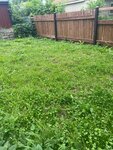

You’ve probably heard of “No Mow May” – a slogan designed to encourage everyone to avoid mowing their lawns until June and letting spring flowers bloom to support pollinators. But with our historically warm winter, overall changing climate, and new pollinator research, “No Mow May” is out and “Slow Mow Summer” is in! Read on for updated guidance and advice for managing your lawn with pollinators in mind.
Spring is a critical time for pollinators – in particular, many bees begin to come out of hibernation in May and need flowers available as a food source. The idea behind “No Mow May” is that many lawns contain flowering plants (or weeds, depending on your perspective) such as dandelions and clover, and these flowers could provide food for pollinators at an important time of year.
The problem with “No Mow May” is that lawns can grow a lot at that time of year, especially in a year like this one, with a very mild winter and early spring thaw. If you don’t mow at all in May, you could end up with 12-18 inches of grass in early June, which is a challenge for even the most advanced lawn mowers! In addition to the practical considerations, cutting your grass by more than one-third of the plant’s height at one time can stress the lawn, making it more susceptible to damage and disease. Very long grass can also retain excessive moisture and block airflow, creating ideal conditions for fungus to thrive. So, for several reasons, it’s not ideal to let your grass get extremely long and then cut a large portion of the plant in one mowing.
This year, the University of Minnesota Bee Lab released updated lawn mowing guidance that provides a more long-term perspective on pollinator health. Rather than not mowing at all in May and then mowing regularly the rest of the summer, the Bee Lab now recommends “Slow Mow Summer.” Essentially, “Slow Mow Summer” involves planting blooming flowers in your lawn, and allowing those flowers to bloom before mowing. Additionally, this approach encourages mowing less often all summer long. Instead of focusing on flowering plants only in the month of May, “Slow Mow Summer” provides support for pollinating insects throughout the spring and summer.
White clover, self-heal, ground plum, violets, and pussy toes are some low-growing flowering plants that you can incorporate into your lawn to add blooms and support pollinators all summer. If you’re concerned about flowering plants spreading and taking over too much of the lawn, you can always mow after the plants have bloomed, but before they go to seed. This will help reduce spreading while still providing support to pollinating insects. In my own yard, I have plenty of yarrow planted among the grass. It has small white flowers and also soft, feathery green foliage – so it still looks a lot like a traditional lawn when freshly mowed. I also have quite a bit of creeping thyme, which is very low growing, has cute purple flowers, and smells great when you walk on it!
The Bee Lab also has advice for protecting pollinators when cleaning up flower beds in the spring. Some pollinators hibernate under leaves and in last year’s plant stems, so it’s best to wait a bit longer to clear out any dead leaves or stems. Once you see a lot of blooming trees and flowers, and notice bees and other insects out and about, that’s a good sign that it’s ok to clean up dead leaves. Certain types of bees nest in stems, and they may not emerge from hibernation until mid-June or later. If you decide to remove last season’s stems before mid-June, place them in a pile in your yard rather than tossing them in the yard waste bin. This will give overwintering bees a chance to finish their hibernation.
For more information on the Bee Lab and Slow Mow Summer, visit beelab.umn.edu/slow-mow-summer and the University of Minnesota Extension Yard and Garden website. Extension resources are written by experts and contain the latest and most reliable research-based information. Happy gardening!
Comments
No comments on this item Please log in to comment by clicking here